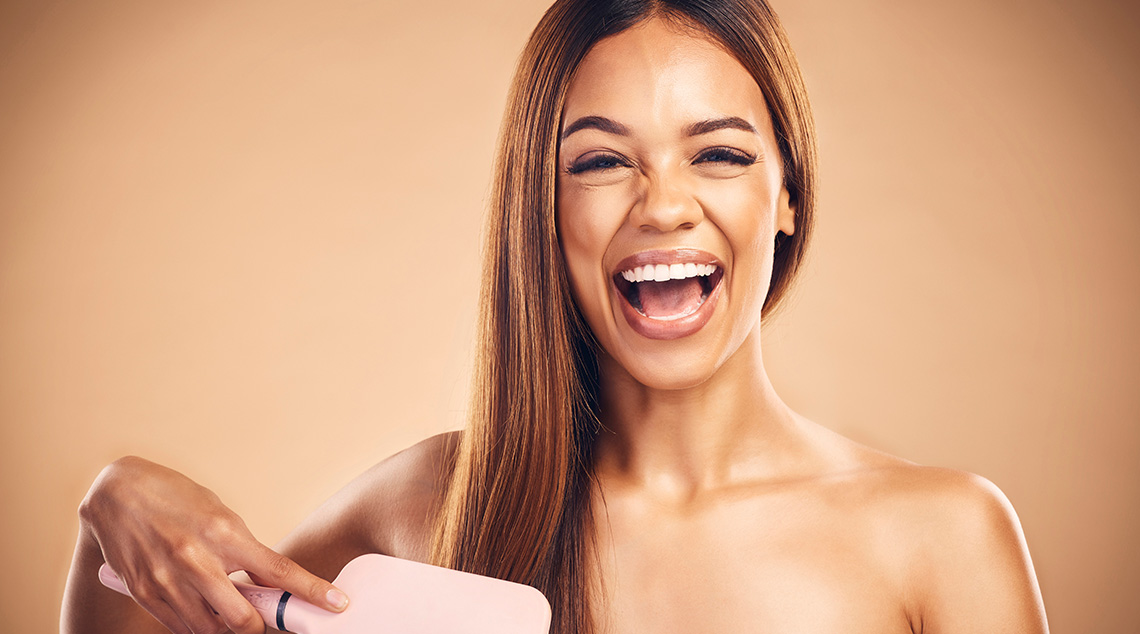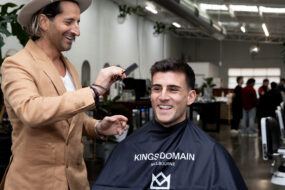Hair conditioner 101: Your ultimate guide to lustrous locks
This is your essential guide to hair conditioner, including the product types and washing techniques experts say will leave your locks in great shape.
Nothing says soft and shiny like freshly conditioned hair.
But hair conditioner is more than just a sidekick to your shampoo – it can be the difference between frizzy or damaged locks and lustrous, healthy hair.
Choosing haircare products can be overwhelming, so we spoke to the experts about the best conditioner options for each hair type.
On this page:
- What is hair conditioner?
- Is conditioner good for your hair?
- How to apply hair conditioner?
- How often should you use hair conditioner?
- Types of hair conditioners
- How to pick the right conditioner for your hair
- Can you use hair conditioner to shave?
- Should you use hair conditioner with a hair mask?
- Can hair conditioner be used to remove lice?
What is hair conditioner?
Acting as a moisturiser, detangler and protector, hair conditioner can be quite the multitasker.
“When you shampoo your hair, you’re opening up the hair strand to clean it,” hairstylist and Harpo Hair founder Posey Broomhall says.
“If the strand is left open, it becomes knotty and more receptive to damage, whereas a good conditioner will close the strand plus hydrate, smooth and detangle your hair,” Posey, of Melbourne, says.
Hair conditioning also protects your locks from the elements.
“Conditioner is like a sealer for your hair and can protect it from heat drying, styling tools, and outside influences like aircon, sun, humidity and weather,” Posey explains.
Is conditioner good for your hair?
In a nutshell, yes. Conditioner nourishes your hair, and formulas will often include humectants, sealing oils such as argan or coconut, water and natural ingredients.
“Natural nourishing agents like orchid, lotus flower and desert lime help to reduce breakage and prepare the hair for styling without weighing it down or leaving it feeling greasy,” Posey says.
How to apply hair conditioner
Shampoo and conditioner go together for good reason, as a thorough shampooing sets a clean base for conditioner to do its job, Posey says.
“Hair should be squeaky clean in order for the conditioner to fully penetrate the hair strand,” she notes.
Posey recommends shampooing twice, especially if your hair is extra dirty or you use products such as hairspray or dry shampoo.
After washing, remove as much excess water as possible before applying conditioner.
“Apply a hazelnut-sized blob of conditioner to the mid-lengths and ends, and run what’s left on your hands through the roots,” Posey says.
“Leave for the recommended amount of time on the bottle then rinse.”
If you have a particularly dry scalp, Glo Hair hairstylist Grant Norton says applying conditioner to the roots and massaging the scalp with your fingertips can have a moisturising effect.
“This can help soften and moisturise a stressed scalp,” Grant says.
How often should you use hair conditioner?
As a guide, Grant recommends using shampoo and conditioner on your hair every three days.
However, this can vary between hair types, and can depend on lifestyle and environmental factors such as exercise and hot weather.
View this post on Instagram
Types of hair conditioners
Everyday conditioner
Keep this type of conditioner on standby for regular washes.
Posey recommends choosing a product that suits your hair type, and using it after every shampoo.
Leave-in conditioner
Leave-in conditioners are designed to protect the hair from styling tools and the environment.
“These products will continue to protect and nourish the hair between washes,” Posey says.
Grant recommends a spray leave-in conditioner for fine hair types.
“A leave-in conditioning spray lets you control the result,” he says.
“It offers all the benefits of closing the hair cuticle but adds manageability and shine without weighing your locks down.”
Deep conditioner
A deep conditioner offers extra hydration.
“A deep conditioner can be used once a week and left in your hair for around 20 minutes,” Posey says.
These products are more concentrated than regular conditioners and penetrate the hair to provide a deeper, more nourishing effect.
“Deep conditioners often have a lower pH level, which means they can reach further into the hair shaft,” Grant explains.
How to pick the right conditioner for your hair
Hair conditioners are formulated for different hair types, so it’s important to choose one with suitable ingredients and properties.
Conditioner for frizzy hair
To help turn frizz into curls, Grant recommends a moisturising conditioner for curly hair and a light rinsing technique.
“A great trick is to condition the hair, but don’t rinse the conditioner out fully – leave about five per cent in there,” he says.
“This helps keep the hair shiny and soft and can help curl with curl formation, especially in frizzy hair.”
Conditioner for dry hair
It’s no secret that dry hair lacks moisture, so this is where leave-in products provide lasting hydration.
“Use a leave-in conditioner once a week and try a leave-in hair oil too,” Posey says.
“This helps keep hair nourished not just on wash days, but every day.”
Conditioner for damaged hair
Whether damaged from hot styling tools, colouring or chemical services, damaged hair needs moisture and protein to repair.
Look for a balance of moisture-promoting ingredients, which make hair soft and supple, and protein ingredients to strengthen the hair, Grant suggests.
“A rich and heavy everyday conditioner will also help to control frizz and flyaways,” he says.
Conditioner for thin hair
A lightweight conditioner is the way to go for thin hair.
“Try either a spray and leave-in conditioner, or a conditioner that’s specifically made for fine hair,” Grant says.
“Fine hair conditioners prioritise strengthening ingredients like keratin or quinoa.”
Conditioner for oily hair
It may be tempting to wash oily hair daily, but Grant suggests washing every three days to reduce excess oil production.
And when it comes to washing, certain techniques work better for an oily scalp.
“The most important step for oily hair is shampooing,” Grant says.
“When working the shampoo into your scalp, use gentle circle motions with your palms rather than scrubbing with your fingertips.
“When it comes to conditioner, avoid applying to the roots and stick to the middle and ends of the hair.”
Conditioner for blonde hair
You’ve likely heard of purple shampoo, but a purple conditioner can moisturise and tone at the same time.
“A purple conditioner closes the hair cuticle, which means the colour pigment is going to sit more on the top layer of the hair,” Grant says.
Instead of a wash-and-rinse purple shampoo, a pigmented conditioner gives you more control.
“You can test how many minutes to leave it in for, and find the perfect time to suit your hair type and desired blonde tone,” Grant says.
View this post on Instagram
Can you use hair conditioner to shave?
Hair conditioner can moisturise body hair and soften it for an easier shave.
Ingredients such as glycerin and coconut oil often feature in both hair conditioners and shaving cream formulas, and work to hydrate the skin.
Should you use hair conditioner with a hair mask?
A leave-in hair treatment, often known as a hair mask, can act as a standalone conditioning product.
“(These) leave-in conditioners are applied to the mid-lengths and ends and left in the hair,” Posey says.
If you do wish to also use a regular conditioner for extra nourishment, always apply it after you’ve rinsed out the mask.
Can hair conditioner be used to remove lice?
More than just a moisturiser, hair conditioner can come in handy for removing head lice.
Conditioners can stun lice and make them easier to remove using the popular “wet combing” technique, which involves wetting a comb with water and conditioner and manually combing out nits and lice.
Read more on hair care:
- How to protect your hair from sun damage
- 20 haircare dos and don’ts
- How to get the nutrients healthy hair needs
- How to avoid and correct brassy hair
Written by Hayley Hinze




